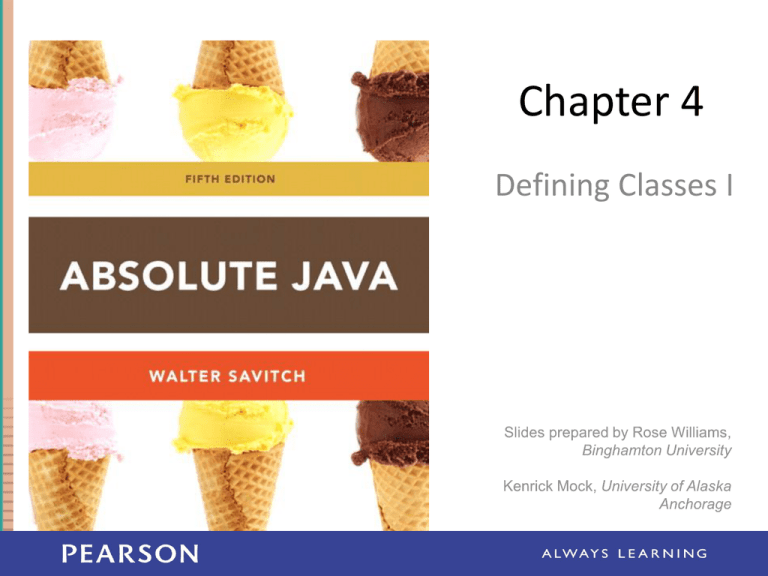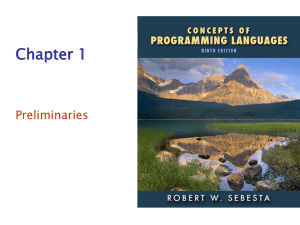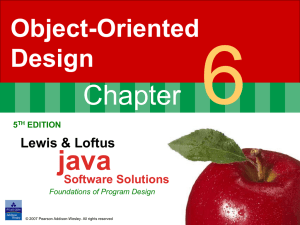
Chapter 4
Defining Classes I
Introduction
• Classes are the most important language feature that
make object-oriented programming (OOP) possible
• Programming in Java consists of defining a number of
classes
– Every program is a class
– All helping software consists of classes
– All programmer-defined types are classes
• Classes are central to Java
Copyright © 2012 Pearson Addison-Wesley. All rights reserved.
4-2
Class Definitions
• You already know how to use classes and the objects
created from them, and how to invoke their methods
– For example, you have already been using the predefined
String and Scanner classes
• Now you will learn how to define your own classes
and their methods, and how to create your own
objects from them
Copyright © 2012 Pearson Addison-Wesley. All rights reserved.
4-3
A Class Is a Type
• A class is a special kind of programmer-defined type,
and variables can be declared of a class type
• A value of a class type is called an object or an
instance of the class
– If A is a class, then the phrases "bla is of type A," "bla is an
object of the class A," and "bla is an instance of the class
A" mean the same thing
• A class determines the types of data that an object
can contain, as well as the actions it can perform
Copyright © 2012 Pearson Addison-Wesley. All rights reserved.
4-4
Primitive Type Values vs. Class Type Values
• A primitive type value is a single piece of data
• A class type value or object can have multiple pieces
of data, as well as actions called methods
– All objects of a class have the same methods
– All objects of a class have the same pieces of data (i.e.,
name, type, and number)
– For a given object, each piece of data can hold a different
value
Copyright © 2012 Pearson Addison-Wesley. All rights reserved.
4-5
The Contents of a Class Definition
• A class definition specifies the data items and
methods that all of its objects will have
• These data items and methods are sometimes called
members of the object
• Data items are called fields or instance variables
• Instance variable declarations and method
definitions can be placed in any order within the
class definition
Copyright © 2012 Pearson Addison-Wesley. All rights reserved.
4-6
The new Operator
• An object of a class is named or declared by a variable of
the class type:
ClassName
classVar;
• The new operator must then be used to create the
object and associate it with its variable name:
classVar = new ClassName();
• These can be combined as follows:
ClassName classVar = new ClassName();
Copyright © 2012 Pearson Addison-Wesley. All rights reserved.
4-7
Instance Variables and Methods
• Instance variables can be defined as in the following
two examples
– Note the public modifier (for now):
public String instanceVar1;
public int instanceVar2;
• In order to refer to a particular instance variable,
preface it with its object name as follows:
objectName.instanceVar1
objectName.instanceVar2
Copyright © 2012 Pearson Addison-Wesley. All rights reserved.
4-8
Instance Variables and Methods
• Method definitions are divided into two parts: a heading and
a method body:
public void myMethod()
{
code to perform some action
and/or compute a value
}
Heading
Body
• Methods are invoked using the name of the calling object and
the method name as follows:
classVar.myMethod();
• Invoking a method is equivalent to executing the method
body
Copyright © 2012 Pearson Addison-Wesley. All rights reserved.
4-9
File Names and Locations
• Reminder: a Java file must be given the same
name as the class it contains with an added
.java at the end
– For example, a class named MyClass must be in
a file named MyClass.java
• For now, your program and all the classes it
uses should be in the same directory or folder
Copyright © 2012 Pearson Addison-Wesley. All rights reserved.
4-10
More About Methods
• There are two kinds of methods:
– Methods that compute and return a value
– Methods that perform an action
• This type of method does not return a value, and is
called a void method
• Each type of method differs slightly in how it is
defined as well as how it is (usually) invoked
Copyright © 2012 Pearson Addison-Wesley. All rights reserved.
4-11
More About Methods
• A method that returns a value must specify
the type of that value in its heading:
public typeReturned methodName(paramList)
• A void method uses the keyword void in its
heading to show that it does not return a
value :
public void methodName(paramList)
Copyright © 2012 Pearson Addison-Wesley. All rights reserved.
4-12
main is a void Method
• A program in Java is just a class that has a main
method
• When you give a command to run a Java program,
the run-time system invokes the method main
• Note that main is a void method, as indicated by
its heading:
public static void main(String[] args)
Copyright © 2012 Pearson Addison-Wesley. All rights reserved.
4-13
return Statements
• The body of both types of methods contains a list of
declarations and statements enclosed in a pair of
braces
public <void or typeReturned> myMethod()
{
declarations
statements
Body
}
Copyright © 2012 Pearson Addison-Wesley. All rights reserved.
4-14
return Statements
• The body of a method that returns a value
must also contain one or more return
statements
– A return statement specifies the value returned
and ends the method invocation:
return Expression;
– Expression can be any expression that
evaluates to something of the type returned listed
in the method heading
Copyright © 2012 Pearson Addison-Wesley. All rights reserved.
4-15
return Statements
• A void method need not contain a return
statement, unless there is a situation that
requires the method to end before all its code
is executed
• In this context, since it does not return a
value, a return statement is used without
an expression:
return;
Copyright © 2012 Pearson Addison-Wesley. All rights reserved.
4-16
Method Definitions
• An invocation of a method that returns a value can
be used as an expression anyplace that a value of the
typeReturned can be used:
typeReturned tRVariable;
tRVariable = objectName.methodName();
• An invocation of a void method is simply a
statement:
objectName.methodName();
Copyright © 2012 Pearson Addison-Wesley. All rights reserved.
4-17
Any Method Can Be Used As a void Method
• A method that returns a value can also
perform an action
• If you want the action performed, but do
not need the returned value, you can
invoke the method as if it were a void
method, and the returned value will be
discarded:
objectName.returnedValueMethod();
Copyright © 2012 Pearson Addison-Wesley. All rights reserved.
4-18
Local Variables
• A variable declared within a method definition
is called a local variable
– All variables declared in the main method are
local variables
– All method parameters are local variables
• If two methods each have a local variable of
the same name, they are still two entirely
different variables
Copyright © 2012 Pearson Addison-Wesley. All rights reserved.
4-19
Global Variables
• Some programming languages include
another kind of variable called a global
variable
• The Java language does not have global
variables
Copyright © 2012 Pearson Addison-Wesley. All rights reserved.
4-20
Blocks
• A block is another name for a compound statement,
that is, a set of Java statements enclosed in
braces,{}
• A variable declared within a block is local to that
block, and cannot be used outside the block
• Once a variable has been declared within a block, its
name cannot be used for anything else within the
same method definition
Copyright © 2012 Pearson Addison-Wesley. All rights reserved.
4-21
Declaring Variables in a for Statement
• You can declare one or more variables within the
initialization portion of a for statement
• A variable so declared will be local to the for loop,
and cannot be used outside of the loop
• If you need to use such a variable outside of a loop,
then declare it outside the loop
Copyright © 2012 Pearson Addison-Wesley. All rights reserved.
4-22
Parameters of a Primitive Type
• The methods seen so far have had no
parameters, indicated by an empty set of
parentheses in the method heading
• Some methods need to receive additional
data via a list of parameters in order to
perform their work
– These parameters are also called formal
parameters
Copyright © 2012 Pearson Addison-Wesley. All rights reserved.
4-23
Parameters of a Primitive Type
• A parameter list provides a description of
the data required by a method
– It indicates the number and types of data
pieces needed, the order in which they must be
given, and the local name for these pieces as
used in the method
public double myMethod(int p1, int p2, double p3)
Copyright © 2012 Pearson Addison-Wesley. All rights reserved.
4-24
Parameters of a Primitive Type
• When a method is invoked, the appropriate values must be
passed to the method in the form of arguments
– Arguments are also called actual parameters
• The number and order of the arguments must exactly match
that of the parameter list
• The type of each argument must be compatible with the type
of the corresponding parameter
int a=1,b=2,c=3;
double result = myMethod(a,b,c);
Copyright © 2012 Pearson Addison-Wesley. All rights reserved.
4-25
Parameters of a Primitive Type
• In the preceding example, the value of each
argument (not the variable name) is plugged
into the corresponding method parameter
– This method of plugging in arguments for formal
parameters is known as the call-by-value
mechanism
Copyright © 2012 Pearson Addison-Wesley. All rights reserved.
4-26
Parameters of a Primitive Type
• If argument and parameter types do not match
exactly, Java will attempt to make an automatic type
conversion
– In the preceding example, the int value of argument c
would be cast to a double
– A primitive argument can be automatically type cast from
any of the following types, to any of the types that appear
to its right:
byteshortintlongfloatdouble
char
Copyright © 2012 Pearson Addison-Wesley. All rights reserved.
4-27
Parameters of a Primitive Type
• A parameters is often thought of as a blank or placeholder
that is filled in by the value of its corresponding argument
• However, a parameter is more than that: it is actually a local
variable
• When a method is invoked, the value of its argument is
computed, and the corresponding parameter (i.e., local
variable) is initialized to this value
• Even if the value of a formal parameter is changed within a
method (i.e., it is used as a local variable) the value of the
argument cannot be changed
Copyright © 2012 Pearson Addison-Wesley. All rights reserved.
4-28
A Formal Parameter Used as a Local Variable
(Part 1 of 5)
Copyright © 2012 Pearson Addison-Wesley. All rights reserved.
4-29
A Formal Parameter Used as a Local Variable
(Part 2 of 5)
Copyright © 2012 Pearson Addison-Wesley. All rights reserved.
4-30
A Formal Parameter Used as a Local Variable
(Part 3 of 5)
Copyright © 2012 Pearson Addison-Wesley. All rights reserved.
4-31
A Formal Parameter Used as a Local Variable
(Part 4 of 5)
Copyright © 2012 Pearson Addison-Wesley. All rights reserved.
4-32
A Formal Parameter Used as a Local Variable
(Part 5 of 5)
Copyright © 2012 Pearson Addison-Wesley. All rights reserved.
4-33
Pitfall: Use of the Terms "Parameter" and
"Argument"
• Do not be surprised to find that people often
use the terms parameter and argument
interchangeably
• When you see these terms, you may have to
determine their exact meaning from context
Copyright © 2012 Pearson Addison-Wesley. All rights reserved.
4-34
The this Parameter
• All instance variables are understood to have <the
calling object>. in front of them
• If an explicit name for the calling object is needed,
the keyword this can be used
– myInstanceVariable always means and is always
interchangeable with this.myInstanceVariable
Copyright © 2012 Pearson Addison-Wesley. All rights reserved.
4-35
The this Parameter
• this must be used if a parameter or other
local variable with the same name is used in
the method
– Otherwise, all instances of the variable name will
be interpreted as local
int someVariable = this.someVariable
local
Copyright © 2012 Pearson Addison-Wesley. All rights reserved.
instance
4-36
The this Parameter
• The this parameter is a kind of hidden
parameter
• Even though it does not appear on the
parameter list of a method, it is still a
parameter
• When a method is invoked, the calling object
is automatically plugged in for this
Copyright © 2012 Pearson Addison-Wesley. All rights reserved.
4-37
Methods That Return a Boolean Value
• An invocation of a method that returns a value
of type boolean returns either true or
false
• Therefore, it is common practice to use an
invocation of such a method to control
statements and loops where a Boolean
expression is expected
– if-else statements, while loops, etc.
Copyright © 2012 Pearson Addison-Wesley. All rights reserved.
4-38
The methods equals and toString
• Java expects certain methods, such as equals and
toString, to be in all, or almost all, classes
• The purpose of equals, a boolean valued method, is to
compare two objects of the class to see if they satisfy the
notion of "being equal"
– Note: You cannot use == to compare objects
public boolean equals(ClassName objectName)
• The purpose of the toString method is to return a
String value that represents the data in the object
public String toString()
Copyright © 2012 Pearson Addison-Wesley. All rights reserved.
4-39
Testing Methods
• Each method should be tested in a program in which it is the
only untested program
– A program whose only purpose is to test a method is called a driver
program
• One method often invokes other methods, so one way to do
this is to first test all the methods invoked by that method,
and then test the method itself
– This is called bottom-up testing
• Sometimes it is necessary to test a method before another
method it depends on is finished or tested
– In this case, use a simplified version of the method, called a stub, to
return a value for testing
Copyright © 2012 Pearson Addison-Wesley. All rights reserved.
4-40
The Fundamental Rule for Testing Methods
• Every method should be tested in a program
in which every other method in the testing
program has already been fully tested and
debugged
Copyright © 2012 Pearson Addison-Wesley. All rights reserved.
4-41
Information Hiding and Encapsulation
• Information hiding is the practice of separating how to use a
class from the details of its implementation
– Abstraction is another term used to express the concept of discarding
details in order to avoid information overload
• Encapsulation means that the data and methods of a class are
combined into a single unit (i.e., a class object), which hides
the implementation details
– Knowing the details is unnecessary because interaction with the object
occurs via a well-defined and simple interface
– In Java, hiding details is done by marking them private
Copyright © 2012 Pearson Addison-Wesley. All rights reserved.
4-42
A Couple of Important Acronyms:
API and ADT
• The API or application programming interface
for a class is a description of how to use the
class
– A programmer need only read the
API in order to use a well designed class
• An ADT or abstract data type is a data type
that is written using good information-hiding
techniques
Copyright © 2012 Pearson Addison-Wesley. All rights reserved.
4-43
public and private Modifiers
• The modifier public means that there are no restrictions on
where an instance variable or method can be used
• The modifier private means that an instance variable or
method cannot be accessed by name outside of the class
• It is considered good programming practice to make all
instance variables private
• Most methods are public, and thus provide controlled
access to the object
• Usually, methods are private only if used as helping
methods for other methods in the class
Copyright © 2012 Pearson Addison-Wesley. All rights reserved.
4-44
Accessor and Mutator Methods
• Accessor methods allow the programmer to obtain the value
of an object's instance variables
– The data can be accessed but not changed
– The name of an accessor method typically starts with the word get
• Mutator methods allow the programmer to change the value
of an object's instance variables in a controlled manner
– Incoming data is typically tested and/or filtered
– The name of a mutator method typically starts with the word set
Copyright © 2012 Pearson Addison-Wesley. All rights reserved.
4-45
Encapsulation
Copyright © 2012 Pearson Addison-Wesley. All rights reserved.
4-46
A Class Has Access to Private Members of All
Objects of the Class
• Within the definition of a class, private
members of any object of the class can be
accessed, not just private members of the
calling object
Copyright © 2012 Pearson Addison-Wesley. All rights reserved.
4-47
Mutator Methods Can Return a Boolean Value
• Some mutator methods issue an error message and
end the program whenever they are given values
that aren't sensible
• An alternative approach is to have the mutator test
the values, but to never have it end the program
• Instead, have it return a boolean value, and have the
calling program handle the cases where the changes
do not make sense
Copyright © 2012 Pearson Addison-Wesley. All rights reserved.
4-48
Preconditions and Postconditions
• The precondition of a method states what is assumed
to be true when the method is called
• The postcondition of a method states what will be
true after the method is executed, as long as the
precondition holds
• It is a good practice to always think in terms of
preconditions and postconditions when designing a
method, and when writing the method comment
Copyright © 2012 Pearson Addison-Wesley. All rights reserved.
4-49
Overloading
• Overloading is when two or more methods in the
same class have the same method name
• To be valid, any two definitions of the method
name must have different signatures
– A signature consists of the name of a method together
with its parameter list
– Differing signatures must have different numbers
and/or types of parameters
Copyright © 2012 Pearson Addison-Wesley. All rights reserved.
4-50
Overloading and Automatic Type Conversion
• If Java cannot find a method signature that exactly
matches a method invocation, it will try to use
automatic type conversion
• The interaction of overloading and automatic type
conversion can have unintended results
• In some cases of overloading, because of automatic
type conversion, a single method invocation can be
resolved in multiple ways
– Ambiguous method invocations will produce an error in
Java
Copyright © 2012 Pearson Addison-Wesley. All rights reserved.
4-51
Pitfall: You Can Not Overload Based on the Type
Returned
• The signature of a method only includes the
method name and its parameter types
– The signature does not include the type returned
• Java does not permit methods with the same
name and different return types in the same
class
Copyright © 2012 Pearson Addison-Wesley. All rights reserved.
4-52
You Can Not Overload Operators in Java
• Although many programming languages, such
as C++, allow you to overload operators (+, -,
etc.), Java does not permit this
– You may only use a method name and ordinary
method syntax to carry out the operations you
desire
Copyright © 2012 Pearson Addison-Wesley. All rights reserved.
4-53
Constructors
• A constructor is a special kind of method that is
designed to initialize the instance variables for an
object:
public ClassName(anyParameters){code}
– A constructor must have the same name as the class
– A constructor has no type returned, not even void
– Constructors are typically overloaded
Copyright © 2012 Pearson Addison-Wesley. All rights reserved.
4-54
Constructors
• A constructor is called when an object of the class is
created using new
ClassName objectName = new ClassName(anyArgs);
– The name of the constructor and its parenthesized list of
arguments (if any) must follow the new operator
– This is the only valid way to invoke a constructor: a constructor
cannot be invoked like an ordinary method
• If a constructor is invoked again (using new), the first
object is discarded and an entirely new object is created
– If you need to change the values of instance variables of the
object, use mutator methods instead
Copyright © 2012 Pearson Addison-Wesley. All rights reserved.
4-55
You Can Invoke Another Method in a
Constructor
• The first action taken by a constructor is to create an
object with instance variables
• Therefore, it is legal to invoke another method within
the definition of a constructor, since it has the newly
created object as its calling object
– For example, mutator methods can be used to set the
values of the instance variables
– It is even possible for one constructor to invoke another
Copyright © 2012 Pearson Addison-Wesley. All rights reserved.
4-56
A Constructor Has a this Parameter
• Like any ordinary method, every constructor has a this
parameter
• The this parameter can be used explicitly, but is more often
understood to be there than written down
• The first action taken by a constructor is to automatically
create an object with instance variables
• Then within the definition of a constructor, the this
parameter refers to the object created by the constructor
Copyright © 2012 Pearson Addison-Wesley. All rights reserved.
4-57
Include a No-Argument Constructor
• If you do not include any constructors in your class, Java will
automatically create a default or no-argument constructor
that takes no arguments, performs no initializations, but
allows the object to be created
• If you include even one constructor in your class, Java will not
provide this default constructor
• If you include any constructors in your class, be sure to
provide your own no-argument constructor as well
Copyright © 2012 Pearson Addison-Wesley. All rights reserved.
4-58
Default Variable Initializations
• Instance variables are automatically initialized in Java
– boolean types are initialized to false
– Other primitives are initialized to the zero of their type
– Class types are initialized to null
• However, it is a better practice to explicitly initialize
instance variables in a constructor
• Note: Local variables are not automatically initialized
Copyright © 2012 Pearson Addison-Wesley. All rights reserved.
4-59
The StringTokenizer Class
• The StringTokenizer class is used to
recover the words or tokens in a multi-word
String
– You can use whitespace characters to separate each
token, or you can specify the characters you wish to
use as separators
– In order to use the StringTokenizer class, be
sure to include the following at the start of the file:
import java.util.StringTokenizer;
Copyright © 2012 Pearson Addison-Wesley. All rights reserved.
4-60
Some Methods in the StringTokenizer
Class (Part 1 of 2)
Copyright © 2012 Pearson Addison-Wesley. All rights reserved.
4-61
Some Methods in the StringTokenizer
Class (Part 2 of 2)
Copyright © 2012 Pearson Addison-Wesley. All rights reserved.
4-62












